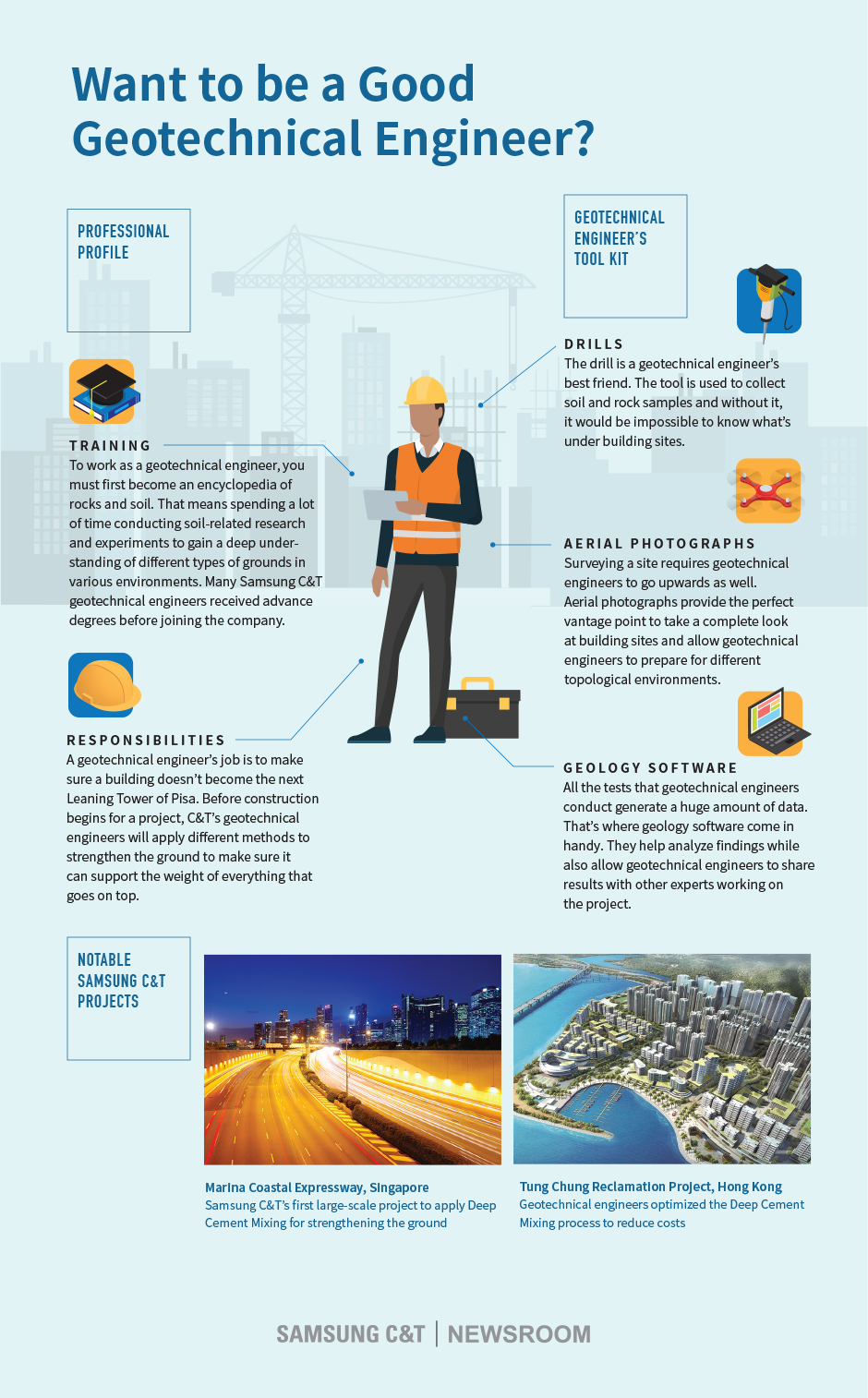The Greatest Guide To Geotheta
The Greatest Guide To Geotheta
Blog Article
The Ultimate Guide To Geotheta
Table of ContentsThe Ultimate Guide To GeothetaSome Known Questions About Geotheta.10 Easy Facts About Geotheta ExplainedHow Geotheta can Save You Time, Stress, and Money.9 Easy Facts About Geotheta Shown

They carry out site examinations, gather samples, perform laboratory tests, and evaluate information to evaluate the suitability of the ground for building and construction jobs - Geo Tech Engineering. Based on their searchings for, geotechnical engineers supply recommendations for foundation layout, incline security, keeping structures, and reduction of geotechnical risks. They collaborate with various other specialists, such as architects, architectural engineers, and building teams, to ensure that geotechnical factors to consider are integrated right into the general job design and implementation
By analyzing the actions and residential properties of soil and rock, they can determine potential geotechnical risks such as landslides, dirt settlement, or incline instability. Their competence assists protect against failures or accidents that might jeopardize lives and residential or commercial property. Below are some in-depth responsibilities and obligations of a geotechnical engineer: Site Examination: Geotechnical engineers conduct website examinations to collect information on subsurface conditions.
They interpret the information to recognize the residential properties and behavior of the soil and rock, including their toughness, permeability, compaction attributes, and groundwater problems. Geotechnical Analysis and Layout: Geotechnical designers evaluate the data gathered throughout site examinations to examine the stability and viability of the site for building and construction jobs. They perform geotechnical calculations and modeling to evaluate variables such as bearing ability, settlement, slope stability, side earth pressures, and groundwater flow.
The Buzz on Geotheta
Foundation Layout: Geotechnical designers play a vital duty in designing structures that can securely sustain the intended structure. They assess the soil conditions and tons requirements to identify the ideal structure kind, such as superficial foundations (e.g., grounds), deep structures (e.g (https://www.tumblr.com/geotheta/757702666915840000/geotheta-has-grown-exponentially-since?source=share)., stacks), or specialized techniques like soil renovation. They think about variables such as settlement limits, birthing capacity, and soil-structure interaction to create optimal foundation designs
They review building and construction plans, monitor website activities, and perform area inspections to validate that the style recommendations are adhered to. If unpredicted geotechnical problems arise, they assess the circumstance and give recommendations for removal or adjustments to the layout. Danger Analysis and Reduction: Geotechnical engineers evaluate geotechnical risks and risks connected with the project website, such as landslides, click to investigate liquefaction, or dirt disintegration.

Collaboration and Communication: Geotechnical designers function closely with various other specialists associated with a project, such as designers, architectural engineers, and construction teams. Reliable communication and cooperation are vital to integrate geotechnical considerations right into the overall job design and building and construction process. Geotechnical designers offer technological proficiency, answer inquiries, and make sure that geotechnical requirements are satisfied.
Some Of Geotheta
Below are some sorts of geotechnical engineers: Structure Designer: Foundation designers focus on designing and evaluating foundations for structures. They evaluate the dirt problems, lots demands, and site features to determine one of the most suitable structure type and style, such as superficial foundations, deep foundations, or specialized strategies like stack structures.
They examine the aspects influencing incline security, such as dirt residential properties, groundwater problems, and incline geometry, and establish methods to avoid incline failings and alleviate dangers. Earthquake Engineer: Quake designers focus on examining and developing structures to stand up to seismic forces. They assess the seismic hazard of a website, assess soil liquefaction possibility, and establish seismic design requirements to ensure the security and durability of structures during earthquakes.
They perform area testing, accumulate samples, and analyze the accumulated data to define the soil homes, geologic developments, and groundwater problems at a site. Geotechnical Instrumentation Designer: Geotechnical instrumentation engineers concentrate on surveillance and gauging the actions of soil, rock, and frameworks. They set up and maintain instrumentation systems that keep an eye on aspects such as soil negotiation, groundwater levels, incline motions, and structural variations to evaluate efficiency and supply very early warnings of prospective concerns.
Unknown Facts About Geotheta
They carry out examinations such as triaxial tests, loan consolidation tests, direct shear examinations, and leaks in the structure tests to gather data for geotechnical analysis and layout. Geosynthetics Designer: Geosynthetics engineers focus on the layout and application of geosynthetic materials, such as geotextiles, geogrids, and geomembranes. They make use of these materials to boost soil stability, reinforce inclines, supply drain remedies, and control disintegration.
They have a tendency to be investigatory individuals, which implies they're intellectual, introspective, and analytical. They are interested, methodical, logical, analytical, and logical. Some of them are additionally social, indicating they're kind, charitable, participating, person, caring, practical, empathetic, sensible, and pleasant - Geo Tech Engineer.
In the workplace environment, geotechnical designers utilize specialized software application tools to perform calculations, develop styles, and analyze information. They prepare records, review task requirements, interact with clients and employee, and coordinate task tasks. The office setting provides a helpful atmosphere for research, evaluation, and collaboration with other professionals associated with the job.
Geotheta for Beginners
They frequently see project websites to perform site investigations, assess geotechnical conditions, and collect information for analysis. These visits include taking a trip to different places, occasionally in remote or difficult surfaces. Geotechnical designers might perform soil tasting, conduct examinations, and monitor building tasks to guarantee that the geotechnical elements of the task are being executed correctly.
Geotechnical designers likewise work in specialized geotechnical labs. Geotechnical research laboratory designers function thoroughly in these atmospheres, managing screening devices, operating instruments, and taping data.
Report this page